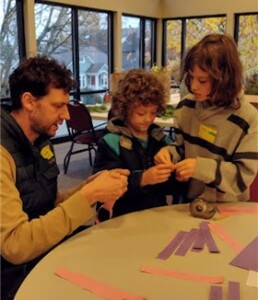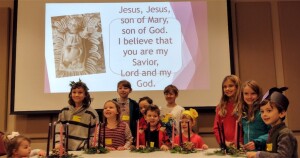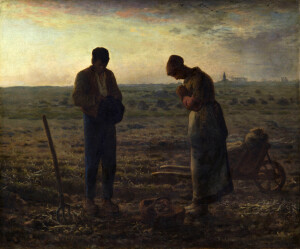A Five-Minute Christmas Homily
By Robert Fontana
The Christmas homily ought to be short! The meaning of the day is made abundantly clear in the carols sung, the readings proclaimed, the liturgy prayed, and the festivities in the home. The homilist need only add an exclamation point to what the Christmas liturgy shouts out with joy! Here’s my Five-Minute Christmas Homily for 2022.
Rob Church, Jesus is Emmanuel, God with us! When I say, “Jesus is Emmanuel,” please shout back to me, “God with us.” Let’s practice. JESUS IS EMMANUEL!
All GOD WITH US!

Rob God became a human being! God was born from the womb of Mary. The baby Jesus needed his diaper changed, needed to nurse in the middle of the night, had to be swaddled when he was cold and carried up and down the stable and sung to when he wouldn’t fall asleep. This little baby Jesus is Emmanuel.
All GOD WITH US!
Rob The child Jesus did not come just to get us to heaven. The child Jesus came to help us have the courage to fully live our lives on earth and to dare to do on earth what is done in heaven.
Isn’t that what we pray in The Our Father: “thy kingdom come, thy will be done on earth as it is in heaven?” And what exactly is done in heaven? Love! Absolute love of God and of one another. Christmas invites us to love God by loving one another, and the earth itself. Jesus is Emmanuel.
All GOD WITH US!
Rob We are not talking about the sentimental love of a Hallmark Christmas movie, where every ending is happy and filled with holiday cheer. No, we are talking about the demanding love of the Gospels, a love that will sacrifice so that others may live, in good times and bad, in sickness and health, in war and in peace. We know what this love looks like: spouses being faithful to one another; foster parents taking in yet another child; elders caring for one another in sickness; citizens advocating for the rights of the unborn, women, and workers; compassionate citizens housing migrants and refugees; and corporate leaders adjusting their business models to help save the earth from the effects of climate change. Jesus is Emmanuel.
All GOD WITH US!

Rob My prayer for all of us this Christmas is for wisdom and courage: the wisdom to figure out how to fully love within the complex and challenging circumstances of life, and the courage to do so. This might mean: simply doing what you are doing at work and home more intentionally for the love of God; sharing possessions and financial resources with persons materially poor; repairing fractured relationships with a spouse or other family members; admitting an addiction to alcohol, pornography, drugs, gambling, shopping, etc., and getting the help needed for sobriety and healthy living. I hope for all of us it will mean avoiding political extremes and working hard to protect our democracy.
Whatever it is you need to do to live out the call to love more wisely and courageously within the circumstances of your life, remember, you and I are not alone. We can draw our strength and inspiration from Jesus, Emmanuel.
All GOD WITH US!
Rob A blessed and holy Christmas. God bless us everyone!
A Different Genealogy of Jesus
Because of God there is the Great Beginning, the emerging universe with its unimaginable energy bursting into time and space.
Because of the Great Beginning and emerging universe there is the formation of fiery stars with their immense power and potency.
Because of the great stars there came to be thousands upon thousands of galaxies, and our unique galaxy called the Milky Way.
Because of the Milky Way Galaxy and its complex evolution, the sun is born and with it the planets that orbit it including Earth with all its creative power and vitality.
 Because of Earth there is the evolution of life through nature from the earliest microbes through the dinosaurs to our world of plants and animals.
Because of Earth there is the evolution of life through nature from the earliest microbes through the dinosaurs to our world of plants and animals.
Because of nature there are humans, women and men, from all corners of the earth, from countless tribes of people.
And because of the one tribe of Judah there is born to Mary of Nazareth the child Jesus called Emmanuel, God with us.
Jesus’ Cosmic Genealogy
Because of God there is the Great Beginning, the emerging universe with its unimaginable energy bursting into time and space.
Because of the Great Beginning and emerging universe there is the formation of fiery stars with their immense power and potency.
Because of the great stars there came to be thousands upon thousands of galaxies, and our unique galaxy called the Milky Way.
Because of the Milky Way Galaxy and its complex evolution, the sun is born and with it the planets that orbit it including Earth with all its creative power and vitality.
 Because of Earth there is the evolution of life through nature from the earliest microbes through the dinosaurs to our world of plants and animals.
Because of Earth there is the evolution of life through nature from the earliest microbes through the dinosaurs to our world of plants and animals.
Because of nature there are humans, women and men, from all corners of the earth, from countless tribes of people.
And because of the one tribe of Judah there is born to Mary of Nazareth the child Jesus called Emmanuel, God with us.
View from the pew: The Difference Between St. Nicholas and Santa Claus
December 6 is the Feast of St. Nicholas, Bishop of Myra (in modern day Turkey). He had a reputation for secretly giving gifts to people in need, which led to the rise among pious Christians of the figure of Santa Claus (Sinterklaas (Dutch: [ˌsɪntərˈklaːs]) or Sint-Nicolaas – https://en.wikipedia.org/wiki/Saint_Nicholas).
Lori and I decided when our children were small to make the Feast of St. Nicholas a special day for them so that they would understand the Christian figure behind the Santa Claus story. We are continuing that custom with the grandchildren. On St. Nicholas Day morning, they will be opening their Christmas stockings, each containing a book, a candy treat, and an orange. For the grands who live above us, we’ll have breakfast together with an ice cream pie as the main dish!
Here’s a reflection on the difference between St. Nicholas and Santa Claus, followed by a prayer service that families (with or without children) or friends can do to honor St. Nicholas, disciple of Jesus, and friend of the poor.
- Santa wants your credit card; Nicholas wants your heart.
- Santa will turn you into a consumer; Nicholas will help you be a servant.
- Santa is a whimsical tale of a fat old elf who gives toys to boys and girls who have been good; St. Nicholas helped children escape from poverty and slavery.
- Santa reminds us to give presents; Nicholas reminds us to give ourselves.
- Santa is controlled by the department store; Nicholas was led by the Spirit.
- Santa is a man dressed in a costume; Nicholas was a Bishop who cared for his people.
 Santa reminds us to follow the Christmas sales; Nicholas reminds us to follow Jesus.
Santa reminds us to follow the Christmas sales; Nicholas reminds us to follow Jesus.- Santa promises us happiness through gift-giving; Nicholas reminds us that happiness is the fruit of a faithful life.
- Santa is a fun story to read to children at Christmas Eve; Nicholas was a man of great compassion who sold his possessions and gave the money to the poor so that he could do God’s will in perfect freedom.
- Santa has nothing to do with Jesus the God-Man whose birth is celebrated on Christmas Day. Nicholas’ life only makes sense because of his love and commitment to Jesus the God-Man whose birth is celebrated on Christmas Day.
A Prayer Service for the Feast of St. Nicholas, Adapted by Robert Fontana from a prayer service by Thomas G. Simons from the St. Nicholas Center.
Call To Worship
Leader: Praise God for St. Nicholas!
Children: Yea St. Nicholas!
Leader: The Spirit of the Lord was upon him.
Children: Yea St. Nicholas!
Leader: Loving God, St. Nicholas loved Jesus, and because he loved Jesus he loved children and the poor. We honor his memory today and in doing so hope to imitate his kindness and love.
Children: St. Nicholas, pray for us. Amen!
Word Service – 1 Peter 5.1–4
The following summary of the life of St. Nicholas may be read and discussed.
St. Nicholas was born to Christian parents. Legends recount the story of Nicholas’ baptism when his parents brought him to the sacred fount; he leapt from his mother’s arms into the Baptismal waters. After the death of his parents, he gave away his inheritance to the poor of Myra, and dedicated himself to serve his people first as a priest and later as a bishop.
Bishop Nicholas preached the Gospel in a Roman culture still dominated by Greek and Roman religious customs and moral behavior. He organized Churched, taught the Catholic faith, and invited non-Christians to join the community of faith. He is most remembered as a helper to the poor and to children. Once Bishop Nicholas heard that a father was struggling to feed his three daughters. He did not have the money for a marriage dowry, and was considering selling them off into slavery so they would at least have something to eat. On three occasions, Bishop Nicholas threw a bag of gold through the window into the room of the sleeping father. His daughters soon were married. Later the father came to Nicholas, fell at his feet and said, “Nicholas, you are my helper.”
This story and his many other works of charity led to the tradition of giving presents on the Feast of St. Nicholas and at Christmas. The name Santa Claus, in fact, evolved from his name.
Bishop Nicholas proclaimed the Gospel, baptized new Christians, feed the hungry and poor, and taught the truths of Christianity. He died at Myra in 350 A.D. His popularity, already great, increased when his bones were brought to Italy in 1087. Both the Eastern and Western churches honor him. St. Nicholas is the patron saint of Russia, Greece, and Sicily. He is regarded as the special patron of children. His feast is December 6.
Intercessions
Reader: For the gift of each person here.
All: We give thanks.
Reader: For the many material blessings that we have received and can share with those in need.
All: We give thanks.
Reader: For a holiday season of joy, hope, and peace.
All: We give thanks.
Blessing Prayer
Leader: Gracious and good Lord, we bless you on this feast of St. Nicholas, your servant, who is an example to us of a life of charity and love.
All: Help us to imitate his good deeds.
Leader: Make us always mindful of the needs of others and help us rejoice in the abundance of your goodness around us. We ask this through Jesus our Lord.
All: Amen.
Our Father…
Share a special treat or exchange small gifts, if desired.
Finally A CLM Event for Families: Advent Preparation
By Lori Fontana
On Saturday, November 26th, CLM partnered with the Care for Mother Earth Social Justice Committee of Assumption Parish, north Seattle, to help families prepare for Advent.
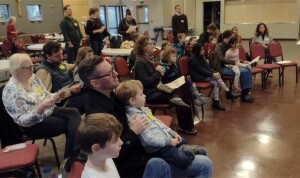 Over 30 people attended – children, parents, and grandparents – to learn about the INCARNATION of Jesus, who came to earth to be with us and all of God’s creation.
Over 30 people attended – children, parents, and grandparents – to learn about the INCARNATION of Jesus, who came to earth to be with us and all of God’s creation.
Through prayer, skits, songs, and crafts, we helped each other enter into the Advent season with a plan for prayer and action.
We watched a children’s video which explains Pope Francis’s letter on the care for creation, Laudato Si. (seehttps://www.youtube.com/watch?v=KIVuISZGdug) Remember, the Incarnation of Jesus is not simply about His saving humans for heaven. Jesus came to teach us how to bring heaven to earth by loving one another and that love includes the “birds of the air and the flowers of the field.” (Matthew 6:28)
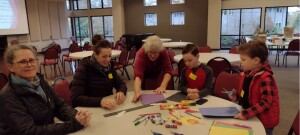 Each family made an Advent wreath to use as a focus for their daily prayer. Also, each family made an Advent chain, to countdown the days until Christmas. On different links of the chain, they wrote what they will do to show care for each other and for God’s beautiful creation.
Each family made an Advent wreath to use as a focus for their daily prayer. Also, each family made an Advent chain, to countdown the days until Christmas. On different links of the chain, they wrote what they will do to show care for each other and for God’s beautiful creation.
It was a lively, fun, and faith-filled time!
It’s not too late to make an advent plan for your family!
 Advent Prayer with the Advent Wreath
Advent Prayer with the Advent Wreath
[Materials Needed: Prayer card; Advent wreath, 3 purple candles, 1 pink candle.]
All O come, O come Emmanuel and ransom captive Israel that mourns in lonely exile here until the son of God appear. Rejoice, rejoice, Emmanuel shall come to you, O Israel.
Leader Come, O Lord, and set us free. All Bring your people peace.
Candle of Promise (1st Week of Advent): I light the Candle of Promise because God made a covenant to our ancestors to save us from sin and evil, and give us peace. This promise has been fulfilled in Jesus. (light 1 candle)
Candle of Hope (2nd Week of Advent): I light the Candle of Hope because God’s beloved son, Jesus, born at Bethlehem, gives us everlasting life. (light 2 candles)
Candle of Joy (3rd Week of Advent) I light the Candle of Joy because God’s beloved Son, Jesus, born of Mary, is our friend. He is “Emmanuel,” “God with us.” (light pink candle, and 2 purple candles)
Candle of Love (4th Sunday of Advent): I light the Candle of Love because God so loved the world that He gave his only son, not to condemn the world, but to save it. (light 4 candles)
Homespun Homily: Presents or Presence; what will you give this Advent?
Every year about this time, I just want to burrow into my favorite cozy chair, wrapped in a fleece blanket, with a mug of cocoa and a good book. Mark Twain describes it well:
“Good friends, good books and a sleep conscience: this is the ideal life.”
But it’s also Advent-tide, one of my favorite seasons of the liturgical year. I normally make a special plan of action and prayer. But this year, the Seattle “Big Dark,” plus my age, leave me feeling a bit tired and unmotivated. Twain’s good book and sleepy conscience sound inviting. How to get motivated to observe this holy season and to grow spiritually…
Advent, with its candles and songs, readings of light and hope and the awaited birth of a little baby, can be a potent antidote for the very dark, very cold, very rainy Seattle winter days.
My conscience, I guess, is not sleepy enough to ignore Advent. In the depths of my heart and soul, I do want to celebrate this lovely season in a concrete and meaningful way. But to do that, I’ll have to push through some very real inertia and make a plan.
How can I mark this holy season? Here are some ways to journey through Advent with spiritual awareness and energy. There are Advent booklets galore, with daily Scriptures, reflections, and suggested activities. I like the offerings of an organization, Creative Communications (CreativeCommunications.com), which has an assortment of Advent prayer booklets for everyone: children, families, seniors; booklets in Spanish and booklets especially for teens. The themes of these booklets range from angel messages to “light,” from the messages in traditional carols to the gentle wisdom of Henri Nouwen. Many parishes offer a reflection booklet for Advent. Find one you like and use it in your daily prayer.
Maybe you’d like to go straight to the Scriptures, the Gospel of Matthew or Luke, reading the birth story of Jesus a little bit at a time and reflecting on the awesome mystery of the Son of God who became a tiny, helpless baby, in Israel, over 2,000 years ago.
Perhaps your prayer could be a daily quiet time: sitting in silence and stillness for 5 or 10 or 20 minutes each morning or each evening, making that a part of each day in Advent. Light a candle, wrap up in a blanket (but, I remind myself to sit up so it doesn’t become naptime!) and just pay attention to your breath and to the mystery of God’s love for YOU. You can whisper a word that draws you into prayer: “Jesus.” “Love.” “Surrender.” “Peace.” A time of stillness like this can be a centering balance to the chaos of the Christmas season, with its parties, presents, cooking, cleaning, traveling, family, guests, late nights, early mornings, wrapping, baking, buying! Doesn’t 20 minutes of quiet sound heavenly?!?
And just a few days ago, I had a gentle revelation about another way to observe Advent with meaning. Robert and I attended Thanksgiving Day Mass. The people gathered were small in number, mostly older folks like us. It was a beautiful time of prayer, singing, a lively homily by our pastor Fr Oliver, and then receiving the Eucharist.
After Mass, we walked out behind an elderly woman. We stopped to introduce ourselves and ask how she would celebrate the day. She told us her name and that she would be with family. But she would be missing her dear husband of 43 years who had passed away last year. She was thinking of her mom, too, who had passed away just three years ago. Then she related a very funny story about how, first her mom, and then later her husband convalesced in the very same room at a care facility. “God has a sense of humor,” she commented. Her memories brought some tears to her eyes and also a smile to her lips.
As we parted, she reached out to shake our hands and said, “Thank you both for stopping to introduce yourselves and say hello. I am grateful.”
 It was a poignant reminder for me: Advent is about the GIFT OF PRESENCE. Our culture says it’s all about PRESENTS! And, of course, presents are nice – fun to buy, fun to receive. But our Christian faith adds a deeper dimension to this season – that of PRESENCE. We will so benefit, body, mind, and spirit, if we take some time to be present to God in prayer, and present to one another. Our visit with the elderly woman after church was only 5 minutes of time, but it was rich in connection and care. Presence makes a difference.
It was a poignant reminder for me: Advent is about the GIFT OF PRESENCE. Our culture says it’s all about PRESENTS! And, of course, presents are nice – fun to buy, fun to receive. But our Christian faith adds a deeper dimension to this season – that of PRESENCE. We will so benefit, body, mind, and spirit, if we take some time to be present to God in prayer, and present to one another. Our visit with the elderly woman after church was only 5 minutes of time, but it was rich in connection and care. Presence makes a difference.
So this Advent – YES, take time for a good book, without the sleepy conscience, though. As many of the Advent Scripture readings point out, we Christians must STAY AWAKE! Take time for reflective prayer and silence, and make time to be present, both to your loved ones and to others you know or meet, who might need a little extra love and care in this holiday season. After all, Jesus’ gift to us at Christmas is his presence in our world and in our lives. For Advent, let’s be generous in sharing that hopeful presence.
Advent, Christmas, and “the most busiest time of the year!”
Here’s a paraphrase of a familiar Christmas song:
“It’s the most busiest time of the year, with the kids and mom yelling and everyone telling you get off your rear! It’s the most busiest time of the year!”
Can’t you hear Andy Williams or Amy Grant singing it? These days from Thanksgiving to Christmas, the secular holiday season, are such a busy and fun time. It’s a struggle for us Fontanas to focus on Advent and the coming of the Christ Child at Christmas when the world around us is immersed in the lights, decorations, parties, and music of the winter holiday season.
Fr. Ron Rolheiser captures the dilemma that many Christians confront during the holiday season: Rolheiser, in his book The Holy Longing, writes something like this: most of us want the holiness and generosity of Mother Teresa when it comes to opening our hearts to the true meaning of Christmas, the birth of Jesus. At the same time, we also want the fun, romantic intimacy, warm ambiance, amazing gifts, delicious desserts, and the multitude of wines, cocktails and beers portrayed in a Hollywood Christmas movie! In the end, according to Rolheiser, what we usually get is an unhappy mixture of both options and end up on Christmas night…well…exhausted.
I do not have a great piece of wisdom to offer you (and me) in resolving this dilemma because it cannot really be resolved. It can be, shall we say, tamed or moderated by a little bit of forethought, wisdom, and courage.
In my youth, I did not approach this issue with wisdom. I had good intentions, but those good intentions only created anxiety, stress, and more work for Lori.
“Lori, let’s make our Christmas gifts for the family gift exchange!”
Great idea, right? Great way to have an “alternative Christmas,” which was all the rage during our college and post college years. However, I DID NOT (AND STILL DO NOT) KNOW HOW TO MAKE ANYTHING WITH MY HANDS! Lori ended up doing all the work and often the projects were not completed until after midnight on Christmas Eve. Good intentions without wisdom make a bad combination. A few dollars spent on some thoughtful and modest gifts would have saved us lots of Christmas misery.
 Of course, at Christmas time, when we consider how the Gospel was first proclaimed to the poor shepherds in the field, we are drawn to reach out to people around us who are materially and spiritually poor. Pope Francis would have us include “nature” in our list of the poor that must be served:
Of course, at Christmas time, when we consider how the Gospel was first proclaimed to the poor shepherds in the field, we are drawn to reach out to people around us who are materially and spiritually poor. Pope Francis would have us include “nature” in our list of the poor that must be served:
“The earth herself, burdened and laid waste, is among the most abandoned and maltreated of our poor; she “groans in travail” (Rom 8:22). We have forgotten that we ourselves are dust of the earth (cf. Gen 2:7); our very bodies are made up of her elements, we breathe her air and we receive life and refreshment from her waters.”
― Pope Francis, Care for our Common Home (Laudate Si)
 The Incarnation of Jesus is not simply about Jesus saving human beings and getting us to heaven. Jesus came to wake us up to our duties on earth to love one another, and that duty extends to caring for the planet which is our only home. We share earth with all other living creatures. We need a healthy planet in order to live healthy lives. The creatures of the earth, from the great birds of prey to the tiniest insects and all growing things can live happily without us humans, but we humans cannot live happy lives without the creatures of the earth and vegetative life. Saving them during this time of climate crisis is how we value and preserve our own lives.
The Incarnation of Jesus is not simply about Jesus saving human beings and getting us to heaven. Jesus came to wake us up to our duties on earth to love one another, and that duty extends to caring for the planet which is our only home. We share earth with all other living creatures. We need a healthy planet in order to live healthy lives. The creatures of the earth, from the great birds of prey to the tiniest insects and all growing things can live happily without us humans, but we humans cannot live happy lives without the creatures of the earth and vegetative life. Saving them during this time of climate crisis is how we value and preserve our own lives.
During the first year of the pandemic, when we couldn’t really gather inside for family parties, we put up a Christmas tree in our front yard and decorated it with food for the birds and, invariably, the squirrels. It was so much fun putting it together and so much fun watching our animal and bird friends enjoy it.
The holiday season is the “most busiest time of the year.” It doesn’t have to be exhausting! Sit down with your loved ones and talk through how you want to observe Advent in preparation for Christmas, while enjoying the secular aspects of the season as well. Have a family meeting in which all get to state their hopes and expectations for the holidays. Pray and ask the Holy Spirit to lead you and your family to wisdom in how you hold together the tension between the secular winter holiday and the Christian season of Advent and Christmas. Set some simple goals following the guidance of the folk singer Donavan as he sang in his song, “Stone by Stone,” written for the movie Brother Sun, Sister Moon:
If you want to live life free, take your time go slowly. Do few things but do them well, simple joys are holy.
Wishing you Advent peace and blessings!
Homespun Homily: A So-so Samaritan
By Lori Fontana
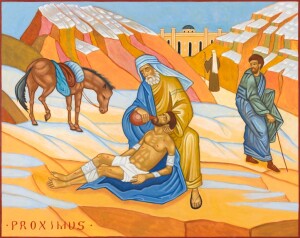 We all know the story of “The Good Samaritan.” (Luke 10:29-37) Jesus teaches his listeners the Great Commandment, which ends with [love] your neighbor as yourself. A scholar in the crowd asks Jesus, “Who is my neighbor?” In response, Jesus tells the well-known parable.
We all know the story of “The Good Samaritan.” (Luke 10:29-37) Jesus teaches his listeners the Great Commandment, which ends with [love] your neighbor as yourself. A scholar in the crowd asks Jesus, “Who is my neighbor?” In response, Jesus tells the well-known parable.
It is a parable relevant for today. Who is my neighbor? How far afield does Jesus’ directive go? Is it the people who live to the right and left of me? Is it my relative with whom I don’t get along? Is it the man or woman living in the park across the street? Just who is my neighbor, Jesus? Really, how far do I have to stretch with this?
And what does loving my “neighbor” actually look like? Is it a donation to the mission? Volunteering at the food bank? Inviting someone in need to my dinner table? The interpretations and possibilities are endless. I want to have the loving, compassionate heart of the Good Samaritan, but do I have the time, the energy, the resources, the courage?
In my younger years, I really did believe that we Christians could “solve” all the woes and problems of society. If everyone pitched in and worked together, there would be enough food, enough shelter, enough care and camaraderie to pull every person out of need. But the older I get (and I am still learning), I’ve grown to believe that, as Jesus said , “The poor you will always have with you…” (Matthew 26:11) However, I don’t hear Jesus saying, “Just throw up your hands in defeat and walk away!” Jesus says quite the opposite: “Amen, I say to you, whatever you did for one of these least brothers [and sisters] of mine, you did for me.” (Matthew 25:40)
So I walk around with this mental tug-o-war each time I encounter someone in need. Is this my neighbor? And if so, what should I do? What can I even manage to do for her or him? The problems are so huge, and I feel inadequate and, many times, afraid to try to help.
Several weeks ago, on a gray, chilly, misty day, I walked home from the post office (rubbing elbows with my “post office prodigals!”). Ahead, I saw a pile of boxes and bags around a huge yellow umbrella, and a large dog. Having once been bitten by a stray dog, I swung widely around this pooch who seemed to be guarding the mound of assorted items. Then I saw two legs poking out from beneath the umbrella. There was a person in there. Hmmm.
 I continued walking home, but my conscience was pricked. Here was someone who looked to be in need. What to do? I arrived home, and paced a bit before I decided I could AT LEAST bring the person some hot chocolate. I mixed it up in a “to go” cup with a lid and trekked back to where the person was sitting. The dog was now lying down. I couldn’t even see the person, but I called out, “Would you like some hot chocolate?”
I continued walking home, but my conscience was pricked. Here was someone who looked to be in need. What to do? I arrived home, and paced a bit before I decided I could AT LEAST bring the person some hot chocolate. I mixed it up in a “to go” cup with a lid and trekked back to where the person was sitting. The dog was now lying down. I couldn’t even see the person, but I called out, “Would you like some hot chocolate?”
Immediately, the person responded, “Yes!” The voice was that of a young woman. I approached slowly, wary of the dog.
All I could see were the woman’s legs so I offered, “If you put your hand out, I’ll hand you the hot chocolate.” She extended an arm, I gave her the cocoa, and I handed her a card advertising the Ravenna Pop-Up Kitchen, where we distribute food once a week for neighbors. “I hope you enjoy the cocoa.” She responded with a thank you. I asked her name – “Kat” – and her dog’s name – “Max.” I said she would be very welcome to come by the next day to the Pop-Up Kitchen for food and toiletries. Then I was on my way.
Back in my own warm home, I had mixed feelings. A cup of cocoa is such a tiny band aid for such a BIG problem. I’m not the Good Samaritan by a long shot; but maybe I’m at least the “So-so Samaritan.” Though a small gesture, I did something; I acknowledged this sister human being; I went a little bit out of my way to offer a tiny kindness.
 Maybe that’s the point. Most of us cannot solve society’s big problems. But all of us can do something to show care. Even the smallest gesture can lift another person up and give them hope. We can ask the Holy Spirit for guidance, courage, and strength; and the Spirit will open our eyes to how we can help. Mother Teresa said, “Every time you smile at someone, it is an action of love, a gift to that person, a beautiful thing.” If each one of us shares what we can, we will be better than a “so-so Samaritan.” We will be the Good Samaritan – the hands and feet, the heart and voice of Jesus to a weary world.
Maybe that’s the point. Most of us cannot solve society’s big problems. But all of us can do something to show care. Even the smallest gesture can lift another person up and give them hope. We can ask the Holy Spirit for guidance, courage, and strength; and the Spirit will open our eyes to how we can help. Mother Teresa said, “Every time you smile at someone, it is an action of love, a gift to that person, a beautiful thing.” If each one of us shares what we can, we will be better than a “so-so Samaritan.” We will be the Good Samaritan – the hands and feet, the heart and voice of Jesus to a weary world.
Is it a sin to vote for an “election denier?” Yes, if…
Did you hear the story of the Irishman Paddy who fell and hit his head. His friends gathered around him and, unable to rouse him, pronounced him dead. They put him in a coffin and carried him to the graveyard. On the way to the cemetery, the pallbearers slipped and dropped the coffin. Paddy, jolted awake by the fall, sat up and said, “Hey fellas, what’s going on?” His friends shouted back, “You’re dead!” They pushed him back down into the coffin, nailed it shut, and proceeded on to the cemetery.
Moral: When a rigidly held belief bumps into solid facts, the rigidly held beliefs usually win.
Dear readers, I’m not making a political and partisan argument here, but a moral one. Bear with me.
“Election Deniers!” It is hard to believe, but the numbers are legion. Against all the evidence, they spout the lie created and perpetrated by the former president that the 2020 presidential election was stolen! That he, Donald J. Trump, is the rightful president. And that Joe Biden, the current occupant of the White House, is there by fraud.
NOTHING COULD BE FURTHER FROM THE TRUTH. Donald Trump’s own cyber security chief stated that it was the safest election (safe from fraud) in US history. 60 of 61 court filings by Trump lawyers and supporters to challenge the election results were thrown out as were two appeals to the US Supreme Court. And now, with the testimonies of many former Trump staffers and Republican party leaders to the January 6 congressional committee, including statements from his former attorney general, Catholic Bill Barr, we know that Trump was told that the election was fairly won, that he admitted it in private that it was fairly won, and that he still refused to publicly accept the results. In fact, he had a premeditated plan dating back to months before the election to plant the notion that the only way that he could lose the election is by fraud.
Joseph Goebbels, Hitler’s propaganda minister, once said, “If you tell a lie big enough and keep repeating it, people will eventually come to believe it. The lie can be maintained only for such time as the State can shield the people from the political, economic and/or military consequences of the lie. It thus becomes vitally important for the State to use all of its powers to repress dissent, for the truth is the mortal enemy of the lie, and thus by extension, the truth is the greatest enemy of the State.” (Inspiringquotes.us)
 In the Catechism of the Catholic Church, lying is defined as a sin, and the gravity of a lie is measured by the “truth it deforms, the circumstances, the intentions of the one who lies, and the harm suffered by its victims.” It follows that a lie that “does grave injury to the virtues of justice and charity” is a mortal sin (Art 2484). The “big lie” that the 2020 election was stolen does such “grave injury” because it greatly undermines “justice and charity,” thereby eroding trust in democracy. (I think Catholic bishops, clergy, and lay leaders must publicly condemn this lie and tell the Catholic community the truth that Joe Biden is the legally and fairly-elected president of the United States.)
In the Catechism of the Catholic Church, lying is defined as a sin, and the gravity of a lie is measured by the “truth it deforms, the circumstances, the intentions of the one who lies, and the harm suffered by its victims.” It follows that a lie that “does grave injury to the virtues of justice and charity” is a mortal sin (Art 2484). The “big lie” that the 2020 election was stolen does such “grave injury” because it greatly undermines “justice and charity,” thereby eroding trust in democracy. (I think Catholic bishops, clergy, and lay leaders must publicly condemn this lie and tell the Catholic community the truth that Joe Biden is the legally and fairly-elected president of the United States.)
You may recall that in the 2020 presidential race between Donald Trump and Joe Biden, there were some Catholic clergy and laity giving homilies and making social media posts that it was a sin to vote for a Democrat. I objected to these homilies and social media posts as being inconsistent with Catholic teaching. Here’s what Joseph Ratzinger, later Pope Benedict XVI, wrote:
A Catholic would be guilty of formal cooperation in evil, and so unworthy to present himself for Holy Communion, if he were to deliberately vote for a candidate precisely because of the candidate’s permissive stand on abortion and/or euthanasia. When a Catholic does not share a candidate’s stand in favour of abortion and/or euthanasia, but votes for that candidate for other reasons, it is considered remote material cooperation, which can be permitted in the presence of proportionate reasons. (Worthiness to Receive Holy Communion: General Principles. Cardinal Joseph Ratzinger, 2004)
So, is it a sin to vote for a politician that promotes the “big lie” that the 2020 election was stolen? The answer, consistent with Catholic moral teaching is, “Yes” if a reason one is voting for a politician is because he/she is a proponent of the “big lie.” One may vote for an election denier if one has other morally valid reasons to vote for him/her. However, to vote for an election denier, in part, because he/she is an election denier, would be a sin, as defined in Catholic teaching.
What about people who sincerely believe that the 2020 election was stolen? Are they guilty of sin if they vote for an election denier precisely because he or she is an election denier? Yes! When a person refuses to adopt a position because of a rigidly held belief, even though the facts are glaring that the rigidly held position is wrong, that person is guilty of willful ignorance. Holocaust deniers are guilty of the sin of that great lie. Advocates who deny that the unborn fetus in a mother’s womb is a baby are guilty of the sin of that great lie. And individuals and groups who refuse to accept the glaring evidence that the 2020 election was freely and fairly won by Joe Biden and deliberately vote for election deniers are guilty of the sin of that great lie.
The Marian Angelus and the St. Joseph Angelus
Leader: The Angel of the Lord declared unto Mary. All: And she conceived of the Holy Spirit.
Hail Mary, full of grace, The Lord is with Thee; Blessed art thou among women, And blessed is the fruit of thy womb, Jesus. Holy Mary, Mother of God, Pray for us sinners, Now and at the hour of our death. Amen
Leader: Behold the handmaid of the Lord. All. Be it done to me according to thy word. Hail Mary. . .
Leader: And the Word was made flesh. All. And dwelt among us. Hail Mary. . .
Leader: Pray for us, O holy Mother of God. All That we may be made worthy of the promises of Christ.
(Conclude with Grace if prayed before a meal or with the following:)
Leader: Let us pray. All: Pour forth, we beseech Thee, O Lord, Thy grace into our hearts, that we to whom the Incarnation of Christ Thy Son was made known by the message of an angel, may by His Passion and Cross be brought to the glory of His Resurrection. Through the same Christ Our Lord. Amen.
Leader The angel of the Lord said, “Joseph, son of David, do not be afraid to take Mary your wife into your home…
All … for it is through the Holy Spirit that this child has been conceived in her.” Blessed Saint Joseph, husband of Mary, come to my aid, especially in times of anguish and difficulty.
Leader “She will bear a son and you are to name him Jesus…
All …because he will save his people from their sins.” Blessed Saint Joseph, husband of Mary, come to my aid, especially in times of anguish and difficulty.
Leader “Behold, the virgin shall be with child and bear a son…
All … and they shall name him Emmanuel, which means ‘God with us.’” Blessed Saint Joseph, husband of Mary, come to my aid, especially in times of anguish and difficulty.
(Conclude with Grace if prayed before a meal or with the following:)
Leader: Let us pray. All: Pour forth, we beseech you, O Lord, your grace into our hearts; that we to whom the Incarnation of Christ, your Son, was made known by the message of an angel, may by his Passion and Cross be brought to the glory of his Resurrection through the same Christ our Lord. Amen.



